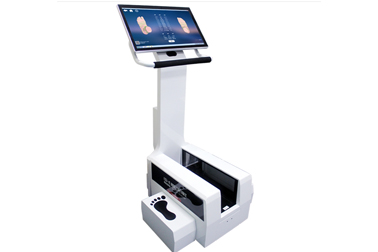What functions does a foot scanner have?
1. It uses lasers to “understand” your feet
The core technology of a foot scanner is laser-based 3D reconstruction. It projects laser lines onto the surface of the foot and, combined with high-precision cameras or sensors, captures spatial coordinates of various points on the foot to generate a complete 3D model.
The entire process is non-radiative and contactless. Common scanning accuracy can reach ±0.5 mm, which is far more precise than manual measurements. In other words, this machine doesn’t just provide a rough image — it can accurately capture even the curvature between your toes.
2. Main Function 1: Foot Shape Modeling
This is the most fundamental and crucial function of a foot scanner.
The device can accurately measure foot length, width, height, instep curvature, inner and outer foot angles, and other key data. It can even model left and right feet separately, solving the common issue of foot asymmetry.
3. Main Function 2: Customized Footwear Design
Once the 3D model is obtained, things get interesting. Based on this model, you can customize:
Functional insoles: Provide support or cushioning for structural issues such as flat feet, high arches, or overpronation;
Customized athletic shoe lasts: Make running shoes fit the foot shape more precisely and enhance athletic performance;
Orthopedic shoes: Assist in correcting pathological foot shapes under medical guidance;
Children’s growth shoes: Dynamically record foot development in children to guide shoe selection and foot care.
To put it simply: it’s no longer about your foot adapting to the shoe, but about the shoe adapting to your foot.

4. Main Function 3: Dynamic Foot Shape Tracking
Although a laser scanner performs static modeling, it can be used repeatedly to create time-series data. This is especially useful in the following scenarios:
Monitoring child development: Scan every six months to observe arch formation and bone growth;
Postoperative recovery tracking: Compare foot models before and after surgery to assist doctors in evaluating recovery progress;
Foot shape changes during weight fluctuations or pregnancy: Record how foot shape evolves under increased load.
Its “dynamic” function doesn’t refer to instant motion capture, but to long-term data accumulation and trend analysis.
5. Main Function 4: Abnormal Foot Detection and Early Warning
By comparing the scanned model with a standard foot shape database, the foot scanner can help identify the following issues:
Forefoot or rearfoot too wide, which may lead to hallux valgus or heel tilt;
Instep too high or collapsed, indicating arch abnormalities;
Disordered toe alignment, which may affect shoe fit and comfort.
While this cannot replace a doctor’s diagnosis, it can serve as an early warning tool, helping users pay timely attention to their foot health.
